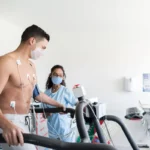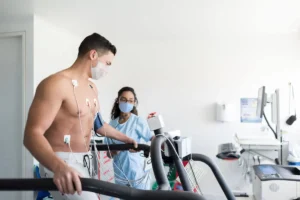What is Gastroenterology?
General Surgery

What is Gastroenterology?
Gastroenterology is a branch of science that deals with digestive system diseases, which is part of the internal medicine department. It examines disorders of all digestive system organs from the mouth to the anus.
Which organs does it examine?
- Mouth
- Pharynx
- Esophagus
- Stomach
- Duodenum
- Small Intestine
- Large Intestine
- Gallbladder
- Pancreas
Endoscopic examinations include procedures such as gastroscopy, duodenoscopy, rectosigmoidoscopy, and colonoscopy. In gastroenterology, ultrasound technique is also frequently used alongside endoscopic diagnostic methods.
Who is a gastroenterologist?
A gastroenterologist is a physician who specializes in the field of gastroenterology. Gastroenterologists must complete a subspecialty in gastroenterology after their internal medicine residency.
Which diseases does it deal with?
Digestive system organs:
- Stomach ulcers, stomach bleeding
- Reflux disease
- Gastritis
- Jaundice
- Cirrhosis
- Spastic colon (irritable bowel syndrome: IBS)
- Gallstones and inflammation
- Indigestion
- Diarrhea
- Colitis (ulcerative colitis, Crohn’s)
- Constipation
- Liver diseases (hepatitis A, B, C, cirrhosis, fatty liver, jaundice)
- Familial Mediterranean fever
- Pancreatic inflammation
- Cancers (esophagus, stomach, intestine, liver, pancreas)
- Hemorrhoids
seeks solutions for such known diseases. It would be more beneficial to examine the above-listed diseases in detail.
Gastrointestinal tract diseases
Diseases of the esophagus are generally called gastrointestinal tract diseases. It deals with the diagnosis and treatment of disorders that cause difficulty swallowing in the esophagus, sharp and penetrating foreign objects that enter the esophagus, and bleeding and damaged areas in the esophagus caused by harmful foreign liquids consumed.
Stomach diseases
Gastroenterology science deals with the diagnosis and treatment of gastritis, stomach ulcers, reflux disease, stomach cancers, and all types of bleeding originating from the stomach. Removing dangerous foreign objects that have entered the stomach is also within the scope of this scientific field.
Biliary tract diseases
This scientific field deals with gallstones and inflammation, diagnosis and detection of biliary tract diseases and cancers, and removal of biliary tract stones. Additionally, treatments such as stent placement for biliary tract cancers that are too late for surgery are within the working area of gastroenterologists.
Colon diseases
Areas such as spastic colon, ulcerative colitis, Crohn’s disease, colon-related bleeding, diverticula, and diagnosis of colon cancers fall within the working area of gastroenterologists.
Anal region diseases
Hemorrhoids and hemorrhoid-related bleeding, anal fissures, and rectal cancers are diagnosed and treated.
Liver diseases
Another disease that constitutes the working area of gastroenterologists is the liver. Gastroenterologists deal with the diagnosis and treatment of diseases such as causes of acute and chronic hepatitis, liver diseases caused by alcohol and medications, ascitic fluid diseases accumulated in the abdominal membrane, liver cirrhosis and the bleeding it causes, kidney failure caused by cirrhosis, liver cancers that develop after cirrhosis, and liver coma.
What is endoscopy?
Another name for the endoscopy procedure is “gastroscopy”. During gastroscopy, the esophagus, the junction of the esophagus and stomach, stomach, stomach outlet, and duodenum are examined. In endoscopy, the internal parts of these organs are examined through advanced optical devices.
Who undergoes endoscopy?
- Those over 45 years old with stomach complaints
- Those with symptoms such as nausea, vomiting, weight loss
- People whose stomach complaints are not relieved by medication
- Those with upper digestive system bleeding
- Those with suspicious images on stomach X-rays
- Those with a history of stomach cancer
- Those with undiagnosed abdominal pain
- Those over 50 years old with long-term reflux complaints
- Cirrhosis patients
- For control purposes in patients with detected stomach ulcers
- Patients experiencing iron deficiency of unknown cause
- Patients experiencing undiagnosed vitamin B12 deficiency
What is colonoscopy?
If gastroscopy is performed for the large intestine, this procedure is called “colonoscopy”. In colonoscopy, a tube with a camera at the end is inserted through the anus and the large intestine and the parts of the small intestine adjacent to the large intestine are visualized. Before the colonoscopy procedure, the patient is given laxative medication because the intestines need to be cleaned. It is the most reliable method for diagnosing colon (large intestine) cancer. In colonoscopy, non-cancerous large intestine diseases (Crohn’s disease, ulcerative colitis, etc.) can be diagnosed and monitored. With this method, diagnosis and treatment of large intestine bleeding can be provided, saving patients from surgery.
Who undergoes colonoscopy?
- For screening purposes for early diagnosis of bowel cancer in the over-50 age group
- In those with suspicious appearance on bowel X-rays
- For investigating iron deficiency-related anemia
- In those with a history of bowel cancer and polyps
- In patients with rectal bleeding or hidden blood detected in stool
- In those with colon cancer in family genetics
- In monitoring ulcerative colitis and Crohn’s disease
- In those with long-term diarrhea complaints
What is ERCP?
ERCP (endoscopic retrograde cholangiopancreatography), an endoscopic intervention, is used in the diagnosis and treatment of obstructive diseases in bile and pancreatic ducts. A special endoscope is used in ERCP. The endoscope used examines the bile ducts that open into the duodenum. It enables the diagnosis and treatment of diseases in bile and pancreatic ducts.
What is MRCP?
MRCP stands for ‘Magnetic Resonance Cholangiopancreatography’. In MRCP, imaging of bile ducts, gallbladder, and pancreatic duct is provided with an MR device. MRCP method, which is not an interventional procedure and is only used for diagnostic purposes, has no therapeutic aspect. Treatment of diseases related to bile and pancreatic ducts diagnosed with ultrasound, tomography, or MRCP is performed with the ERCP method.
Which treatments and procedures are performed?
- Diagnosis and treatment of esophageal diseases
- Diagnosis and treatment of stomach and intestinal diseases
- Diagnosis and treatment of gallbladder and bile duct diseases
- Diagnosis and treatment of liver diseases such as hepatitis and cirrhosis
- Diagnosis and treatment of pancreatic diseases
- Application of endoscopic procedures
- Non-surgical removal of polyps
- Opening and widening of esophageal and stomach strictures with balloon or bougie
- Band treatment for esophageal varices
- Stent placement in esophagus, stomach, and large intestine cancers to ensure nutrition and prevent obstruction
- Imaging of bile ducts and pancreatic ducts with ERCP
- Non-surgical stone removal from bile ducts with ERCP
- Stent placement in bile duct strictures with ERCP
- Endoscopic feeding tube placement in the stomach
- 24-hour pH measurement for reflux diagnosis
- Capsule endoscopy application
- Endoscopic ultrasonography (EUS) performance
- Gastric balloon application as a diet aid in obesity cases where weight loss through diet has been unsuccessful















